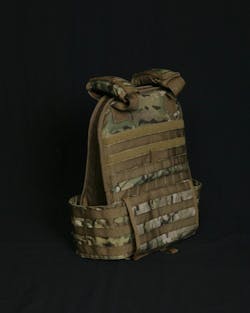MITgel Stand Alone Plate Carrier
Physical Characteristics:
Low profile, 1000 denier Cordura® Teflon coated shell, inner lining is moisture wicking, fast drying and odor absorbing, Anti-microbial and anti-bacterial materials, MITgel 4D WRAP comfort and ballistic reduction panels, Side opening tactical vest, Area of coverage approximately 1,085 Square Inches, Velcro-release for emergency removal, Available in 5 sizes, Weight (medium) = 10.5 pounds, Front and rear plate pocket accepts ESAPI, ESBI and XSAPI for protection, 4 point comfort adjustment, 6 inch elastic side straps – Velcro® closure with Fastex® buckle back up, Interior suspension system to stabilize ballistic pad, Velcro® bottom closure, Map pocket, PALS, MOLLE compatible, Available for Male and Female users.
Performance Characteristics:
Plate carrier with MITgel 4D WRAP comfort and ballistic reduction panels reduce impact, control core body temp (2 degree gain or loss over 8 hours of wear), Soft Armor provides ballistic, fragmentation, Stab, cut, slash and needle protection, Anti-microbial and anti-bacterial, 9mm protection V-0: 1650fps, .357 V-0: 1,759 fps, .44 MAG V-0: 1,651 fps, Avg. 9mm BFS 16mm, Avg. .357 BFS: 22.38mm, Avg. .44 Magnum BFS: 26.42mm, Level IIIA+, Thinness/weight: 0.7 inches (18mm)/1.98 lbs/sqft, ESAPI & ESBI – 7.62mm (M-80 Ball), 7.62 LPS, 5.56 (M855) and 7.62 APM2 protection – XSAPI – Classified.
FIIG: not yet assigned
TEST RESULTS
Back Face Signature (BFS)
Ballistic resistance testing of MITgel Bullet Proof Vests in an accredited NIJ Ballistic Testing Laboratory recorded a BACK FACE SIGNATURE (BFS) at 16 mm and an average BFS of 28.67 mm. MITgel body armor BFS are the lowest among bullet proof vests in the market today. MITgel vests are the only body armor that has both ballistic protection component and a blunt force trauma panel.
V50 (Ballistic Limit Test)
- V50 testing, as used by body armor manufacturers, experimentally identifies a velocity at which a specific projectile has a 50-percent chance of penetrating the armor being tested.
- Using Ballistic Resistance of Body Armor NIJ Standard-0101.06 ballistic limit is defined (for a given bullet type), the velocity at which the bullet is expected to perforate the armor 50 % of the time. The ballistic limit is typically denoted as the V50 or V50 value.
- The V50 ballistic limit is calculated as the average velocity of the 10 bullets. V50 ballistic limit testing allows manufacturers to evaluate various designs against one another to optimize their design for a specific type of body armor. A trend has emerged in which manufacturers publish V50 test data and also put V50 test information on the labels of some of their body armor.
- The higher the V -50 rating, the greater the ballistic protection is at that level.
- V50 ballistic limit testing is a useful and informative statistical tool for evaluating certain characteristics of armor. In addition to being helpful during the design phase of armor development, it may also have the potential for being a valuable tool in evaluating armor’s degradation over time. However, it does not evaluate the level of protection afforded against blunt force trauma.
- NIJ standards states that V50 For a given bullet type, is the velocity at which the bullet is expected to perforate the armor 50 % of the time. The ballistic limit is typically denoted as the V50 or V50 value.
TEST RESULTS OF MITgel Lined LEVEL IV PLATES: Department of Defense: accredited laboratory: Dynamics Research Institute
Multi Strike plates (NIJ Level IV) lined with MITgel were tested for impact reduction. The test was documented using Fuji Film. This type of film is pressure sensitive and reports the magnitude and distribution of pressure acting upon an object. Force (load) represents the magnitude of energy transferred to the chest; and pressure-how this force is distributed (the area over which it is applied). The human body is susceptible to injury both as a function of force as well as trauma caused to the area over which that force is applied i.e. Blunt Force Trauma.
Results of the Fuji film tests visually validate that multi strike plates with MITgel reduce the risk of trauma to the body.
On the other hand, the picture of the multi strike plates with MITgel indicated negligible impact pressure as demonstrated by the highly diffused or lack of red color. In fact, the pressure is so low that it barely registers on the Fuji film. The Fuji film test results on the multi strike plate with MITgel clearly manifest outstanding evidence that MITgel absorbs energy and dissipates the impact forces over a large area.
In biomechanical terms, the reduced pressure from the energy transfer or force applied to the body equals a reduced probability and risk of injury or blunt force trauma to the body.
